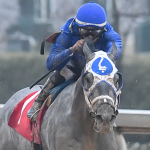
Preakness Quick Sheet: Get to Know the 2021 Preakness Horses

When Sir Barton became the first horse to win the Kentucky Derby, Preakness Stakes, and Belmont Stakes in 1919, he created an elite standard that only 12 other horses have matched since.
Eleven years after Sir Barton’s accomplishment, Gallant Fox secured racing’s second Triple Crown, and five years later, his son Omaha captured the third. Both colts carried William Woodward’s Belair Stud silks and were trained by “Sunny Jim” Fitzsimmons.
Author Jennifer Kelly, realizing an in-depth volume dedicated to each of these pioneers did not exist, became determined to research and share their stories. Her first book, “Sir Barton and the Making of the Triple Crown,” was published in 2019. Critical success led to her second book, “The Foxes of Belair: Gallant Fox, Omaha, and the Quest for the Triple Crown,” available May 9.
In this book, Kelly relays that a dream took root when a young Woodward was eating breakfast with his father, who remarked that Pierre Lorillard was the first American to win the Epsom Derby (with Iroquois).
“I made up my mind [not knowing if I could ever own a racehorse or hardly what a racehorse was] to be the second American to win the Derby,” Woodward said.
Woodward passionately studied pedigrees, and he was willing to dedicate significant financial resources to building a legacy. He built his equine empire on his family’s Belair estate in Maryland.
When trainer Fitzsimmons was a child, Leonard Jerome and William K. Vanderbilt were among a coalition who purchased 112 acres — that included the Fitzsimmons family home — near the village of Sheepshead Bay to build a racetrack. The Fitzsimmons were allowed to stay while the track literally went up around them but had to leave once the project was almost completed.
Years later, Fitzsimmons was an established trainer, and Woodward asked him to train his horses. Together, they dominated a decade.
Woodward began realizing his childhood dreams of winning classics with Gallant Fox. His Triple Crown was filled with intrigue. At this time, the Preakness came before the Kentucky Derby. A week later, he was in Louisville for the Derby, and so was Edward George Villiers Stanley, 17th Earl of Derby, a descendant of the race’s namesake, who witnessed Woodward’s first win. The Belmont was billed a clash of champions: Gallant Fox battled Harry Payne Whitney’s prized Whichone, who had beaten the Fox in the Futurity at Belmont Park.
Rarely tested in his career, Gallant Fox had depth to his talent. Woodward was eager for him to begin his stud career after his 3-year-old season.
“From his first crop would come 17 foals, with one standing head and shoulders above the rest, both literally and figuratively,” Kelly writes. “From the first crop of this Triple Crown winner came something special: Omaha.”
The short 2-year-old races did not showcase the type of talent that belonged to long-legged Omaha. He earned only one win in his lackluster first season. Still, nine months before the Kentucky Derby, famed turf writer Damon Runyon printed his prediction that Omaha would wear the roses. Runyon’s horse swept the series.
Gallant Fox is the only Triple Crown winner to sire a Triple Crown winner, and Woodward was the only owner and breeder to win the three races twice.
One unique aspect of Omaha’s story is that for his 4-year-old season, Woodward sent him to the English turf and the marathon tests of races like the Ascot Gold Cup. Cecil Boyd-Rochfort took over training duties. The book’s prologue captures the Ascot Gold Cup, where Omaha battled Quashed in a race that was called by a placing judge in the absence of a photo finish camera.
“I know some people think of Omaha as one of the lesser Triple Crown winners because he doesn’t have that winning record in the same way that some of the others do, but it’s only because he wasn’t running in the right races for the talent that he had,” Kelly said in an interview. “What he did in England is so singular. He was injured, shipped to England, he acclimated to new surfaces and distances. I don’t think people realized how accomplished he was.”
Omaha retired to stud at Claiborne Farm and was there for many years. When he was 18, leaders of the Nebraska racing scene convinced Woodward to let him stand there to help energize the state’s budding breeding scene. Omaha was celebrated in Nebraska, where he lived out the rest of his days.
Woodward served as chairman of The Jockey Club for 20 years. He started a dozen horses in the Epsom Derby and came within a head of succeeding his childhood dream with Prince Simon in 1950.
The striking prose “The Foxes of Belair” will remind racing enthusiasts why they fell in love with “the sport of kings,” and it provides insight into how these human and equine connections helped shape the current landscape of the sport. The book is available for preorder.